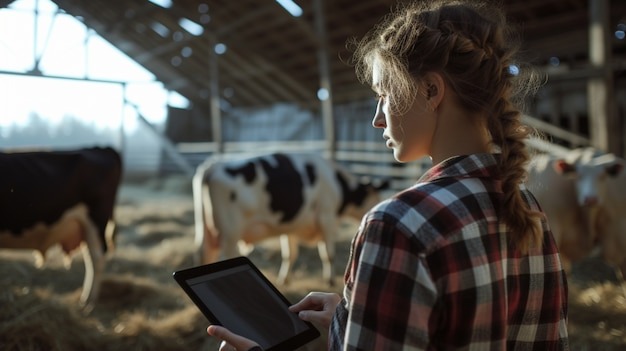In recent years, the intersection of technology and agriculture has ushered in a new era of efficiency and sustainability. One of the most exciting innovations in this domain is AI livestock monitoring, a system that leverages artificial intelligence to track, analyze, and optimize the health and well-being of livestock health monitoring. This technology promises to transform traditional farming practices, offering numerous benefits for farmers, animals, and the environment.
The Rise of AI in Livestock Monitoring
AI-driven livestock monitoring utilizes a combination of sensors, cameras, wearable devices, and machine learning algorithms to gather and interpret data on animals. This data can include vital signs such as temperature, heart rate, activity levels, and even behavioral patterns. By continuously analyzing this information, AI can detect early signs of illness, monitor breeding cycles, track feed consumption, and even predict future health trends.
The need for this technology has never been greater. As global demand for animal products grows, there is an increasing pressure to optimize production while maintaining the health and well-being of livestock. Traditional farming methods, while effective, often rely on manual labor and reactive measures, which can be time-consuming, costly, and sometimes inefficient. AI offers a proactive, data-driven approach to managing livestock that can improve productivity, reduce costs, and ensure animal welfare.
Key Applications of AI Livestock Monitoring
-
Health Monitoring and Disease Detection One of the most impactful uses of AI in livestock management is in health monitoring. Traditional methods of disease detection often involve visual inspection by farmers, which can miss subtle signs of illness until it’s too late. AI-powered systems, on the other hand, can identify anomalies in real-time, such as changes in an animal’s behavior, eating habits, or vital signs. Machine learning algorithms can analyze patterns in this data and flag potential health issues early on, allowing farmers to intervene before diseases spread.
For example, AI systems can detect lameness in cows by analyzing their movement patterns. By identifying this problem early, farmers can address it before it results in costly medical treatment or even the loss of the animal.
-
Breeding and Reproductive Management AI is also playing a crucial role in improving breeding efficiency. By continuously monitoring the health and behavior of livestock, AI systems can predict optimal breeding times, track pregnancy progress, and ensure that cows, pigs, or other animals are bred at the most advantageous moments. This leads to better reproductive success and more efficient livestock management.
-
Feed Optimization and Weight Management AI can help optimize feed efficiency by tracking animals’ consumption patterns and adjusting feed formulations based on their growth stage, health, and environmental conditions. Sensors that monitor feeding behavior can provide valuable insights into an animal’s nutritional needs, enabling farmers to reduce feed waste, save costs, and promote healthier growth.
In addition, AI systems can help manage the weight of livestock, ensuring that they are growing at an optimal rate without being overfed or underfed, which can lead to health issues or suboptimal production.
-
Behavioral Analysis Animal behavior is a key indicator of overall health. AI systems equipped with cameras and sensors can observe livestock behavior 24/7. These systems can detect signs of stress, aggression, or other behavioral changes that may indicate health problems, discomfort, or environmental stressors. Early identification of such issues allows for timely interventions that can improve animal welfare and productivity.
-
Farm Efficiency and Resource Management AI livestock monitoring isn’t just about the animals themselves. It also helps optimize farm operations. By analyzing data on animal movements, environmental conditions, and feed usage, AI can provide insights that help farmers better manage resources like water, space, and labor. For example, AI can predict when animals will need more space, thus avoiding overcrowding and reducing stress. It can also help reduce water usage by monitoring hydration levels and recommending adjustments.
Benefits of AI Livestock Monitoring
-
Improved Animal Welfare With continuous monitoring, farmers can detect signs of distress or illness before they become serious. This means animals can receive prompt care, which not only improves their well-being but also enhances overall farm productivity. AI-driven insights lead to more humane practices, ensuring animals are treated with the highest standards of care.
-
Increased Productivity and Profitability By identifying health issues early, optimizing feed, and improving breeding efficiency, farmers can increase the productivity of their livestock. AI can also reduce the need for expensive veterinary treatments and minimize the losses associated with disease outbreaks, ultimately boosting profitability.
-
Sustainability AI can help farmers make more sustainable decisions. By optimizing feed use, reducing waste, and improving resource management, AI can contribute to a more sustainable agricultural model. This reduces the environmental footprint of livestock farming and helps farmers comply with stricter environmental regulations.
-
Cost Savings AI livestock monitoring systems can reduce labor costs by automating many of the tasks traditionally performed by farmers. They also help reduce veterinary costs by catching problems early, leading to less expensive treatments. Over time, the cost savings generated by these systems can outweigh their initial investment.
-
Data-Driven Decisions The use of AI in livestock monitoring provides farmers with access to vast amounts of data, enabling them to make better-informed decisions. These data-driven insights can be used to refine farming practices, improve operational efficiency, and make long-term strategic plans for farm management.
Challenges and Future Prospects
Despite the numerous advantages, there are still challenges to the widespread adoption of AI livestock monitoring. Initial setup costs can be high, and farmers may face a steep learning curve when integrating these systems into their operations. Additionally, there are concerns about data privacy and the need for robust cybersecurity to protect sensitive information.
However, as technology advances and becomes more affordable, AI livestock monitoring is likely to become an essential tool for farmers around the world. The growing adoption of Internet of Things (IoT) devices, increased connectivity in rural areas, and improvements in AI algorithms are all factors that will help expand the reach and effectiveness of these systems.





